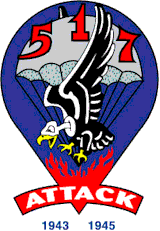 |
517th Parachute Regimental Combat TeamPFC Marvin D. MolesI Company |
 |
 |
517th Parachute Regimental Combat TeamPFC Marvin D. MolesI Company |
 |
Marvin Molesís Helmet History
This amazing journey started 60 years ago with a simple act in Courmes, France during World War II. The third battalion of the 517th Parachute Combat Team was going to Coursegoules by following the Loup River. They were supposed to cross the river by a bridge but the Germans had destroyed the bridge. The third battalion was forced to go over the mountains instead of crossing the river which was an exhausting route. On the way, they passed thru the village of Courmes which is in the French Maritime Alps. Courmes had a population of about 60 people. Tired from the climb up the mountains, the soldiers stopped to rest and they were leaving behind some ammunition and equipment. One soldier named Marvin decided to leave his helmet behind which had his name scraped into the paint. A local teenage boy named Adolph Euziere decided to keep the helmet and engraved into the paint: ďSouvenir of the 24th of August 1944 Adolph EuziereĒ. He left the helmet in the attic of the house his aunt, Josette Euziere lived in.
By 1998, Adolph had died and his aunt had decided to move out of Courmes so she gave the helmet to the owner of the restaurant next door and it was displayed on the wall in the restaurant. During 1999, Max and Maggie Gassend were hiking with their hiking club and stopped to rest a little while in Courmes. They saw the helmet on the restaurant wall and told their son, Jean Loup, about seeing the helmet. Jean Loup had been collecting World War II artifacts and he went with his Dad to Courmes and got the restaurant owner to sell him the helmet. Since the helmet had been stored in the attic for all those years, it was in excellent condition.
Jean Loup found where the name Moles had been scraped into the paint and he checked into the history and found that it had to belong to someone in the 517th Parachute Combat Team. He found that the 517th had a website in early 2004 and he emailed them a picture of the helmet and asked if anyone had information about a Marvin O. Moles. They replied to him that the name was Marvin D. Moles and that his name was on the Christmas roster and the Silver Star Award list. Jean Loup used the internet to get his phone number and tried to call Marvin. The first two times he called he didnít get in touch with him, so he called Gene Moles and asked him if he knew Marvin Moles and Gene told Jean Loup that Marvin is his father. Jean Loup asked Gene to contact his father and tell him to answer the phone in twenty minutes that he had his helmet from World War II and wanted to talk to him about it. The first thing Marvin thought of was the helmet he was wearing in the Battle of the Bulge in Manhay, Belgium. His company had moved behind enemy lines and a U.S. P38 plane came by and dropped bombs on their location. One man lost his arm, the man beside him was killed and the top of Marvinís helmet was cut off down to his hair line. The last thing Marvin remembered was thinking about his wife and saying ďShorty (his nickname for his wife) this is itĒ. When he returned to combat after recuperating in a hospital in England, he was told that his coat he had on blew up into a tree and at first they thought that that was all that was left of him. Marvin told Jean Loup about that helmet and Jean Loup told him he found it in Courmes. They talked that day and Marvin asked what it would cost to get his helmet and Jean Loup told him he would send some pictures for his grandchildren.
Jean Loup did send pictures and a letter telling him how he found the helmet and about some of the battles that the 517th I Company had participated in near that region. Marvin sent pictures to Jean Loup that had been taken in that area during World War II, a copy of his Silver Star document, a copy of the 517th booklet, a paper that his granddaughter had written about his war experience and a booklet about his life prepared by his daughter and son-in-law. Jean Loup sent pictures of the places that were in the World War II pictures showing how they looked now. Marvin sent him a copy of the article that was printed in The Southwest Times telling about the forgotten helmet. After the story appeared in The Southwest Times, Marvinís son Junior was on a service call at Dr. R. B. Hollimanís residence. He told Junior that he read the article and when Junior went to leave he gave him an army helmet that looked similar to the picture in the newspaper and told him to give it to Marvin.
Jean Loup and Marvin talked on the phone several times and Jean Loup asked if Marvin would consider coming to France for the 60th Anniversary of the invasion of Southern France in August 2004. Marvin told him he did not know if he could come then but he would like to meet him sometime and his daughter and son-in-law had said they would take him. Marvin started the process of applying for a passport which was something he did not need 60 years ago when he went to France.
The local newspaper for the Nice, France area was running articles about the 60th Anniversary and Jean Loup talked to one of the reporters. The reporter wrote an article and it appeared on the front page of the local paper with a picture of Jean Loup standing beside the helmet and a picture of Marvin during World War II and he is holding the Southwest Times article. The mayor of Sospel, France saw the article and called Jean Loup and asked him if Marvin would be willing to come to Sospel for the 60th Anniversary of the liberation of Sospel on October 23rd and 24th. Jean Loup also had other calls from people that had some World War II artifacts and they wanted to know how he researched to find information about them. One lady gave him a cup from World War I that had a bullet hole in it for his collection.
Marvin told his daughter, Diane, that if she and her husband Mark would take him he would like to go to France. The preparations were made and on October 21st the three of them left Roanoke and went to Nice, France with layovers in Detroit, Michigan and Amsterdam, Netherlands. The flight attendant on the Northwest Airlines flight from Roanoke to Detroit talked with Marvin about his trip and she told him her father was in World War II and she had just received his army jacket from her Dadís best friend. She told him that it had been in his attic all these years and she thought that was such a coincidence to meet Dad who had a similar story. They arrived in France on October 22nd at 10:00 AM and they were greeted by Max and Maggie Gassend, Jean Loupís parents. Jean Loup was in Croatia starting in Medical School and he would arrive by bus on Saturday. After a scenic drive through Nice, Marvin arrived at the Gassendís home where he would stay during his visit and Mark and Diane stayed at a local motel across from them. The first day Marvin and Diane went with Maggie for a tour of Villeneuve-Loubet. They drove to one of the higher points near the baronís castle and an old church and they looked out over the Mediterranean Sea. They walked down a series of staircases that go between the buildings and weave throughout the town.
The next morning Marvin, Mark and Diane rode with Max and Maggie to Courmes, France so that Marvin could see the place that he left his helmet 60 years before. The roads that lead up the mountain to Courmes were very narrow winding roads with no guard rails. Max would start blowing his horn on the sharp curves so that if there was anyone coming toward him they would wait because only one car could pass. At Courmes, they were greeted by an Italian man and his wife that had moved there near his aunt. He said that he was a paratrooper in Italy for 15 years. They introduced Marvin to two men who were twelve and fourteen when he was there 60 years ago. They said they remembered playing with the helmet and they took everyone down the mountain a short way and showed the group where the soldiers stopped in a clearing to rest. They said they remembered the soldiers playing with them and that the soldiers ate all of the ripe tomatoes on the vines and then they started eating the green tomatoes. They said they wondered if the soldiers got stomach aches from eating the green tomatoes. Marvin told them as a kid in the mountains of Virginia eating fried green tomatoes was common. The two men also said that they remembered splitting logs by taking the powder out of the mortar shells that were left behind and they would drill holes into logs and stick in a short fuse and light it.
The group went back up to Courmes to tour the village and Marvin was introduced to the Italian manís aunt. He said that she was a teenager when the soldiers came through and that one of the soldiers kissed her and she never married. Marvin had his picture taken kissing the lady on the cheek and a picture with the two men that remembered when he came 60 years ago. The group walked around the village and looked at the old church, a cemetery and then to the restaurant and house where his helmet had been. Marvin had his picture taken outside the restaurant and inside standing where the helmet had hung on the wall. The village had about 60 people today and Marvin said that in looking around it looked the almost the same as it did 60 years ago. The two men and the lady were so happy to have Marvin to take time to visit them after all these year. Before he left, they presented him with a jar of honey that they made there with their village information on the label.
They left Courmes and drove to Nice to pick up Jean Loup. Jean Loup and Marvin got to meet each other for the first time. Max, Jean Loup and Marvin road in their car and Mark, Diane and Maggie followed in rental car for the trip to Sospel. Max stopped along the sea near Monaco and took a picture of Marvin and Jean Loup together. The group traveled through Monaco and Matin and then up the mountain to Sospel. When they arrived in Sospel they went to the city square where there was a group of World War II jeeps and trucks on display. They had been left in France during the war and collectors had purchased them and kept them in original shape. Many of them were wearing authentic army uniforms. Marvin met Roland Orengo who was dressed in the 517th uniform complete with the paratrooper boots. The Mayor of Sospel and his assistant greeted Marvin and thanked him for coming to Sospel. The Mayor said that the population of Sospel was about 3,000 people which was the same as in World War II. He said after the war the population went down but that now it was back up. The mayor arranged for Roland to take Marvin in his jeep up the mountain above Sospel to French bunker that was built after World War I as part of the Maginot Line. This is the only bunker that is still completely in tact. The tour went through the whole bunker displaying the medical facilities, the air ventilation system, the weapon storage, the command center, the sleeping quarters and up seven flights of steps the lookout and firing location complete with the original 75 millimeter Howitzer guns. After leaving the bunker, Roland stopped by his home and introduced Marvin to his wife, Patricia. When they arrived back in Sospel, they met with the Mayor at a tavern for some hot chocolate and to discuss the Sunday events.
After arriving back at the Gassendís home, Jean Loup showed Marvin his museum of artifacts and had pictures taken of Marvin, Jean Loup and Marvinís helmet. Jean Loup said the helmet is his most prize possession because it is in such perfect shape where it was in the attic all those years. Jean Loup told Marvin that he does not let anyone touch the helmet and he keeps it in a glass case. Marvin wrote in Jean Loupís guest book for him to keep with the helmet.
The next morning they all traveled back to Sospel for the celebration activities. Marvin met with the Mayor and his assistant outside the church in Sospel. He was introduced to several regional government officials. The Nice Firemanís Corps band led the procession into the church followed by the flag bearers of the countries that participated in the liberation and then the honored guests. The priest greeted everyone and the parish choir sang several songs and the band played some songs. After the priest gave his sermon, everyone went back to the city square where several dignitaries spoke about the liberation of Sospel and the courage of the soldiers and the resilience of the people to overcome the war. The Mayor introduced Marvin Moles and told about his service in the 517th and about how his helmet had been found by Jean Loup. The group went to the restored bridge at Sospel which had been damaged by the German troops during the war. They dedicated a plaque which commemorated the 60th Anniversary of the liberation of Sospel. The procession then walked a short distance to the memorial monument in honor of the soldiers who died during the World War I and II. Marvin Moles presented the wreath in honor of the United States at the monument.
The group proceeded to the banquet hall several blocks away. Jean Loup had to leave with his Dad to go back to the bus station in Nice to get back to college for Monday morning classes. Marvin walked part of the way but then he joined Roland and his wife, Patricia and rode in their jeep with the procession of World War II vehicles. After the meal, the mayor presented several awards including a gold commemorating medal to Marvin Moles for his service in liberating Southern France. Near the end of the banquet, the caterer and the Mayorís assistant presented Marvin with a bottle of local wine that had a picture of Marvin and the dignitaries standing in front of the Memorial Monument just before they placed the wreaths. After the banquet, Marvin, Maggie, Mark and Diane followed the Mayor to the entrance to Sospel and he told them how to take the road back by Col de Braus. Marvin told them that when he was up in those mountains 60 years ago that he thought to himself that he would like to come back someday but that he would have never dreamed that he would 60 years later. The road to Col de Braus zig-zags up the mountain towards Pierra Cava where Marvin earned his Silver Star by aiding a wounded comrade and leading the patrol across an enemy minefield. Marvin remembers that the big trucks would have to back up several times to get around the sharp curves. The road is wider today but it still has the sharp curves that are difficult to see around. It is a common sight to see people bicycling up mountains and it was common to see people that looked like they were in their sixties or seventies bicycling up steep grades.
The next day Marvin, Maggie, Mark and Diane drove around the Coastal cities of the French Riviera. They stopped at the port at Antibes to see an old castle, the many yachts including a very large one belonging to the Saudi royal family. They even came across a yacht that was from Norfolk, Virginia. They went into many of the local shops and stopped at a cafť for the delicious French pastries. They left Antibes and drove to Cannes and visited where the film festival takes place as well as the hotels where the actors and actresses stay. They drove up into the higher elevation at Valbonne and toured the town with its narrow streets and unique shops. In the city square, there were some Indian gentlemen playing music on flutes. They proceeded back to Villeneuve-Loubet and after dinner went on a walking tour of Nice. Marvin remembered getting a pass and he went to Nice during the war and he thought it was a beautiful city and said that it had grown since then but was still a beautiful city.
The next morning Maggie drove Marvin, Mark and Diane to the airport at Nice to start their trip back to Roanoke. They went back through Amsterdam and Detroit before reaching Roanoke, Virginia at 10:55 PM that night. Since returning, he has received pictures from Roland and Patricia Orengo taken during the banquet and Marvin has sent pictures to them as well as to the people he met in Courmes and to Jean Loup, Max and Maggie. A simple act of leaving a helmet with a teenage boy 60 years ago has blossomed into meeting and becoming friends with people that would have never been possible under normal circumstances. It has touched many lives and the memories will last each one a lifetime.
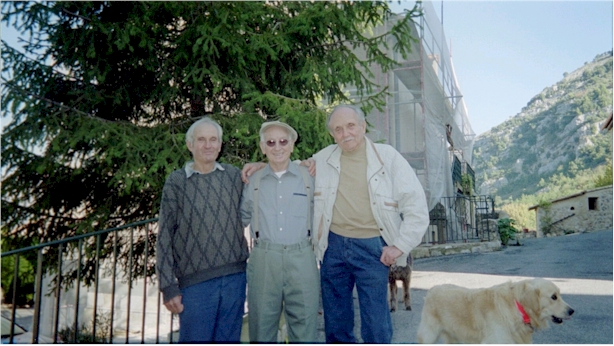
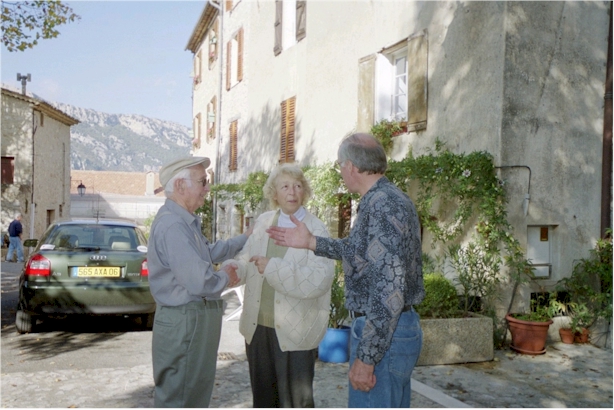
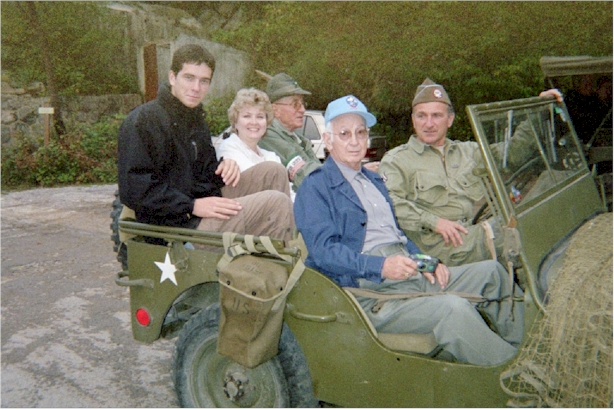
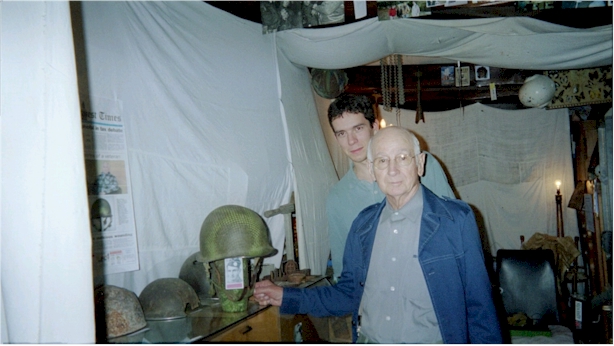
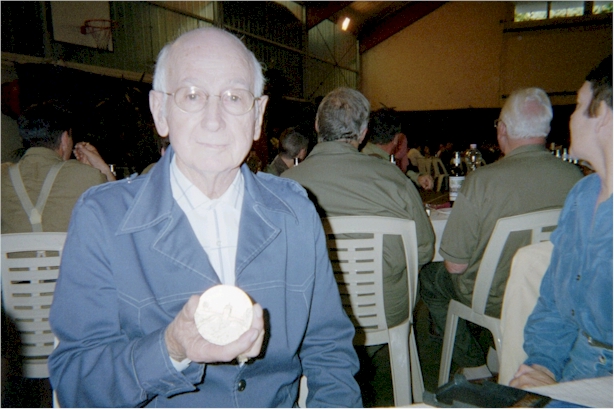
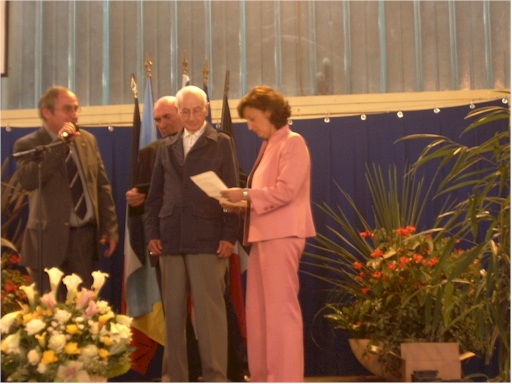
By: Diane M. Lynch
Daughter
(received December 2004)